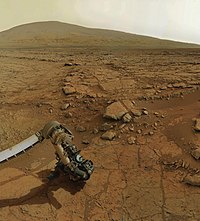
Back Astrobiologie Afrikaans Astrobiolochía AN علم الأحياء الفلكي Arabic استروبيولوجيا ARZ Astrobioloxía AST Astrobiologiya Azerbaijani Astrobioluogėjė BAT-SMG Астрабіялогія Byelorussian Астрабіялёгія BE-X-OLD Астробиология Bulgarian
 |
| This article is one of a series on: |
| Life in the universe |
|---|
| Outline |
| Planetary habitability in the Solar System |
| Life outside the Solar System |
| Habitability of... |

Astrobiology (also xenology or exobiology) is a scientific field within the life and environmental sciences that studies the origins, early evolution, distribution, and future of life in the universe by investigating its deterministic conditions and contingent events.[2] As a discipline, astrobiology is founded on the premise that life may exist beyond Earth.[3]
Research in astrobiology comprises three main areas: the study of habitable environments in the Solar System and beyond, the search for planetary biosignatures of past or present extraterrestrial life, and the study of the origin and early evolution of life on Earth.
The field of astrobiology has its origins in the 20th century with the advent of space exploration and the discovery of exoplanets. Early astrobiology research focused on the search for extraterrestrial life and the study of the potential for life to exist on other planets.[2] In the 1960s and 1970s, NASA began its astrobiology pursuits within the Viking program, which was the first US mission to land on Mars and search for signs of life.[4] This mission, along with other early space exploration missions, laid the foundation for the development of astrobiology as a discipline.
Regarding habitable environments, astrobiology investigates potential locations beyond Earth that could support life, such as Mars, Europa, and exoplanets, through research into the extremophiles populating austere environments on Earth, like volcanic and deep sea environments. Research within this topic is conducted utilising the methodology of the geosciences, especially geobiology, for astrobiological applications.
The search for biosignatures involves the identification of signs of past or present life in the form of organic compounds, isotopic ratios, or microbial fossils. Research within this topic is conducted utilising the methodology of planetary and environmental science, especially atmospheric science, for astrobiological applications, and is often conducted through remote sensing and in situ missions.
Astrobiology also concerns the study of the origin and early evolution of life on Earth to try to understand the conditions that are necessary for life to form on other planets.[5] This research seeks to understand how life emerged from non-living matter and how it evolved to become the diverse array of organisms we see today. Research within this topic is conducted utilising the methodology of paleosciences, especially paleobiology, for astrobiological applications.
Astrobiology is a rapidly developing field with a strong interdisciplinary aspect that holds many challenges and opportunities for scientists. Astrobiology programs and research centres are present in many universities and research institutions around the world, and space agencies like NASA and ESA have dedicated departments and programs for astrobiology research.
- ^ "Launching the Alien Debates (part 1 of 7)". Astrobiology Magazine. NASA. 8 December 2006. Archived from the original on 23 October 2020. Retrieved 5 May 2014.
{{cite web}}: CS1 maint: unfit URL (link) - ^ a b "About Astrobiology". NASA Astrobiology Institute. NASA. 21 January 2008. Archived from the original on 11 October 2008. Retrieved 20 October 2008.
- ^ "About Astrobiology". NASA Astrobiology Institute. NASA. Retrieved 29 January 2023.
- ^ Steven J. Dick & James E. Strick (2004). The Living Universe: NASA and the Development of Astrobiology. New Brunswick, NJ: Rutgers University Press.
- ^ "Origins of Life and Evolution of Biospheres". Journal: Origins of Life and Evolution of Biospheres. Retrieved 6 April 2015.